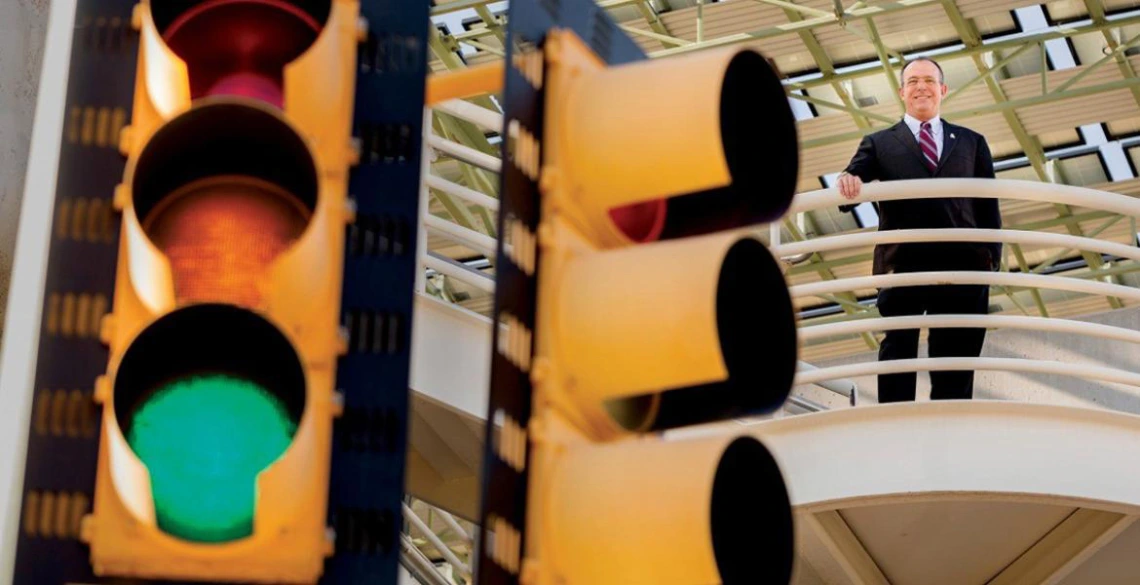Investing in Intelligent Infrastructure
Systems engineers look to enhance public safety with vehicle-to-everything technology.

Larry Head serves on the Arizona Governor’s Task Force for Self-Driving Vehicles and is a member of the Transportation Research Board Traffic Signal Systems Committee and the Intelligent Transportation Systems Committee.
Driving in America is becoming more dangerous. Deadly crashes in the U.S. increased by 16% between 2018 and 2022, according to the National Highway Traffic Safety Administration, and car crashes are the leading cause of death for those aged 1 to 54, per the Centers for Disease Control and Prevention.
University of Arizona engineers plan to reduce congestion and create a safer driving experience with a new traffic signal control system, and local governments are taking notice.
Many Ways to Save Lives
Larry Head, professor of systems and industrial engineering at the College of Engineering, has researched and developed V2X – vehicle-to-everything – communication technology for the past two decades.
V2X uses a shortwave radio signal to send data between vehicles and anything that may be affected by the cars, such as traffic signals, people, bikes and other vehicles. As part of Head’s research, he places a device called a roadside unit at each road intersection and sends traffic signal information to vehicles.
“The hot application right now is red light violations,” Head said. “The unit could tell the vehicle the driver is about to run the red light and could even stop the vehicle.”
Head has been refining his V2X technology in collaboration with the Maricopa County Department of Transportation at a facility in Anthem, Arizona: The SMARTDrive Program Test Bed.
“It's a place where we operate the traffic signals and have special kinds of vehicles, like transit vehicles, trucks and emergency vehicles.”
V2X technology offers a multitude of lifesaving applications. Not only can it prevent collisions by anticipating red light violations, but it could significantly reduce travel time for emergency vehicles. If they become stuck at traffic lights, the V2X system could provide preferential treatment and change lights accordingly – intelligently dictating traffic flow.
“Any time you improve traffic signal timing, you improve safety,” Head said.
Government Buy-In
Inventors of traffic innovations tend to have a difficult time garnering support from local governments, said Head. Funding, personnel, and return on investment debates notoriously halt discussions for transportation improvements.
But Head found an exception in Maricopa County, where the test bed in Anthem is operated in partnership with the county government.
In 2014, Head and his team received $2.56 million from the Connected Vehicle Pooled Fund Study to develop MMITSS: the multi-modal intelligent traffic signals system. The V2X system is being refined at the Anthem test bed, and Maricopa County officials have already agreed to deployments on Buckeye Road in Phoenix as well as other locations in Maricopa County.
Additionally, Maricopa County policymakers are interested in Head’s next venture, a phone application that would send alerts, such as back-of-queue or “congestion ahead” warnings, to drivers’ smartphones. Funded by the U.S. Department of Transportation and the Arizona Commerce Authority, the app will integrate V2X with cellular technology, creating an interface referred to as C-V2X.
Traffic queues are lines of vehicles that typically pile up at intersections and stop signs. These cause delays and increase the chance of crashes, as drivers approaching the back of queues have difficulty judging how much room they need to stop completely.
“We're improving situational awareness,” Head explained. “If you can make the drivers aware of conditions on the roadway early, they have time to slow down and smooth speed out.”
Another municipality has turned its attention to Head’s technology. MMITSS is being deployed in downtown Tampa, Florida, where doctoral student James Clisset is closely monitoring its activity.
There, the SIE graduate student will work with the queue detection mechanism, which regulates traffic to break up congestion.
To make this happen, “the communication is instantaneous,” Clisset said.
The system coordinates traffic signals to ease pileups during rush hour on the expressway.
Clisset admits there are a few issues to work out. But “it's a fun challenge,” he said, adding that MMITSS will have a considerable impact on the lives of the public.
He envisions a future like this with MMITSS:
“If you're driving on a deserted road, you have a green light and then it turns red right before you get there, and there's nobody else around – that will never happen again. The lights will know your position just like a person was detecting traffic and switch it to green for you – it’s real-time intelligence.”


